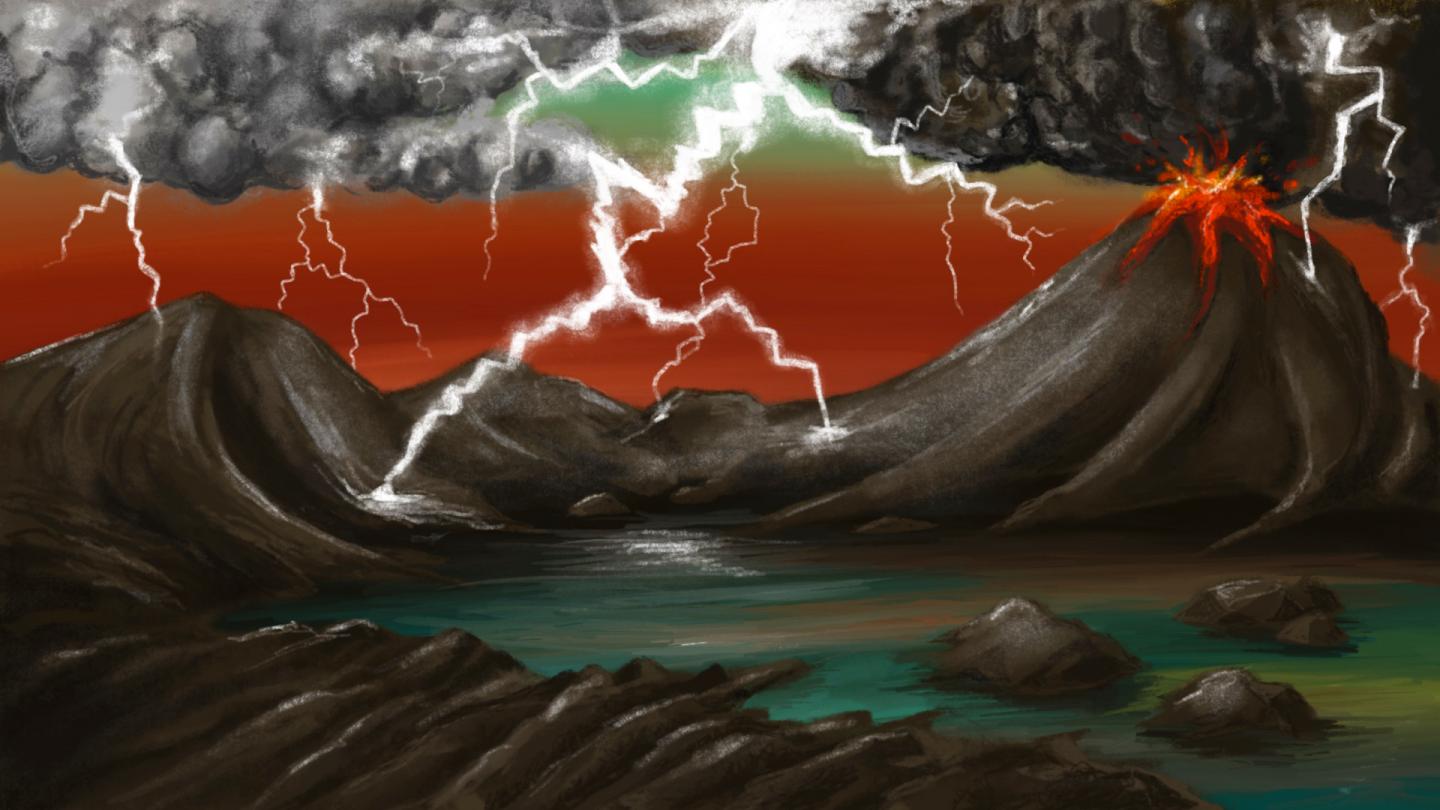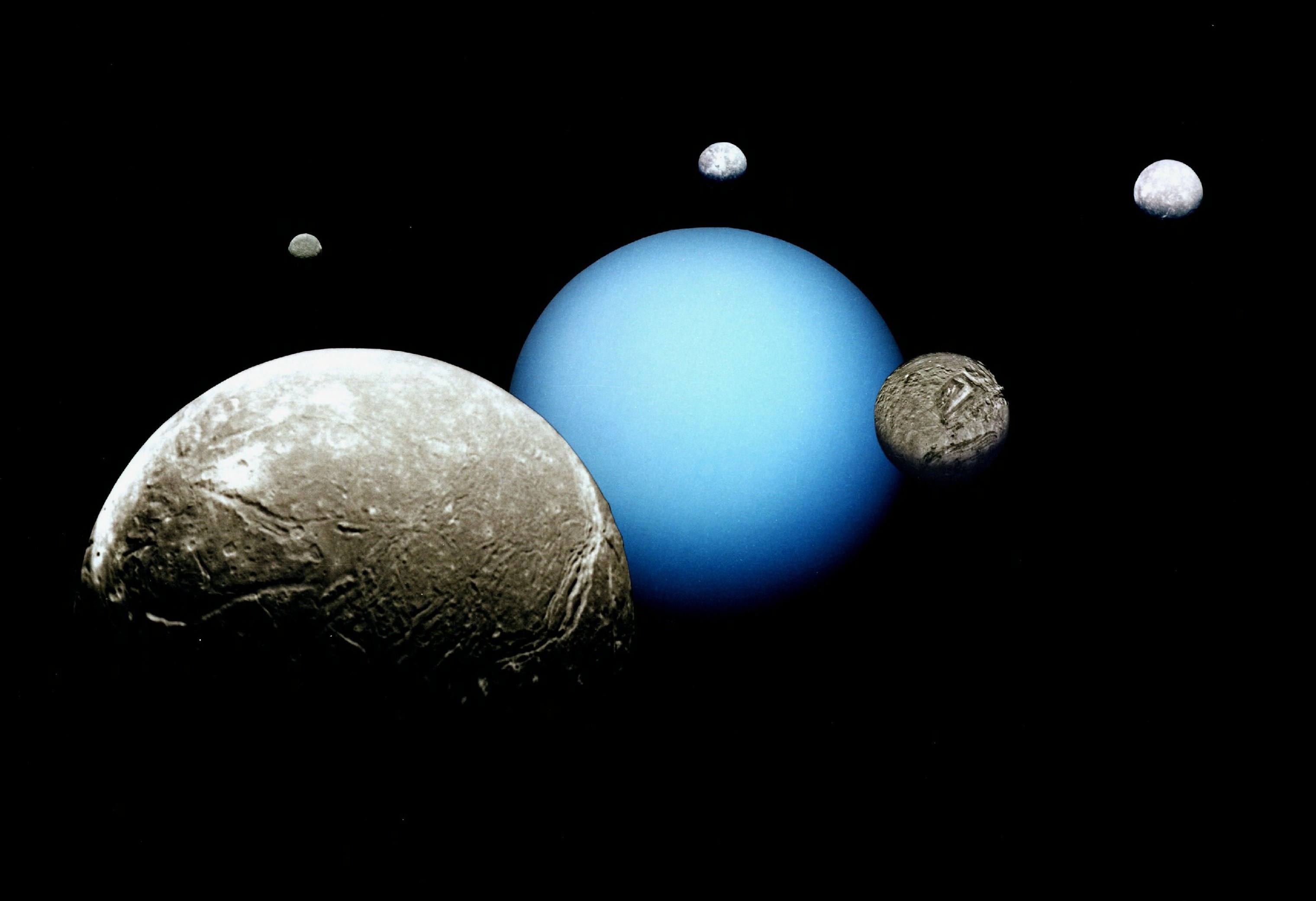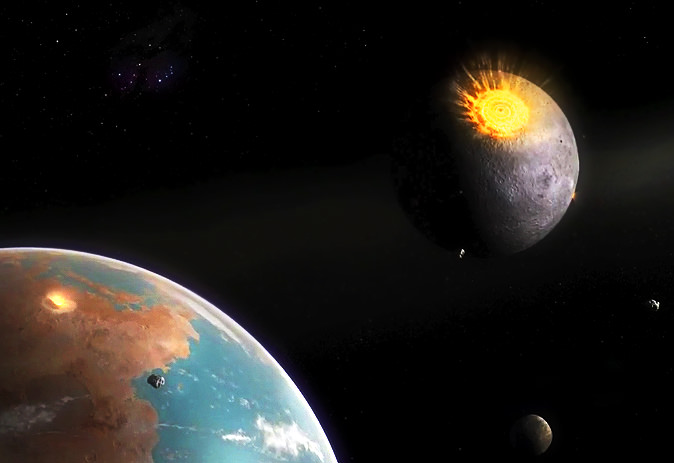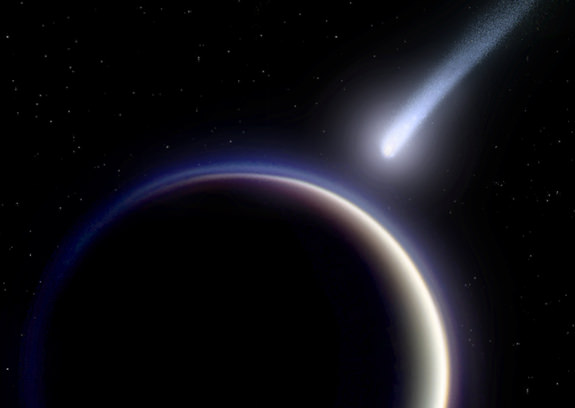So, you want to create life? You’re going to need some ingredients first. On Earth four billion years ago, you might find some of those ingredients in the impact craters of asteroid strikes (as long as you don’t get blown up in the blast yourself). A safer place to look, according to new research from the University of Leeds, might be in the sites of lightning strikes. Lightning is less destructive, more common, and creates equally useful minerals out of which you can build your early, single cellular life forms.
Continue reading “Lightning Strikes Helped Life get an Early Start on Earth”Earth and Venus are the Same Size, so Why Doesn’t Venus Have a Magnetosphere? Maybe it Didn’t Get Smashed Hard Enough
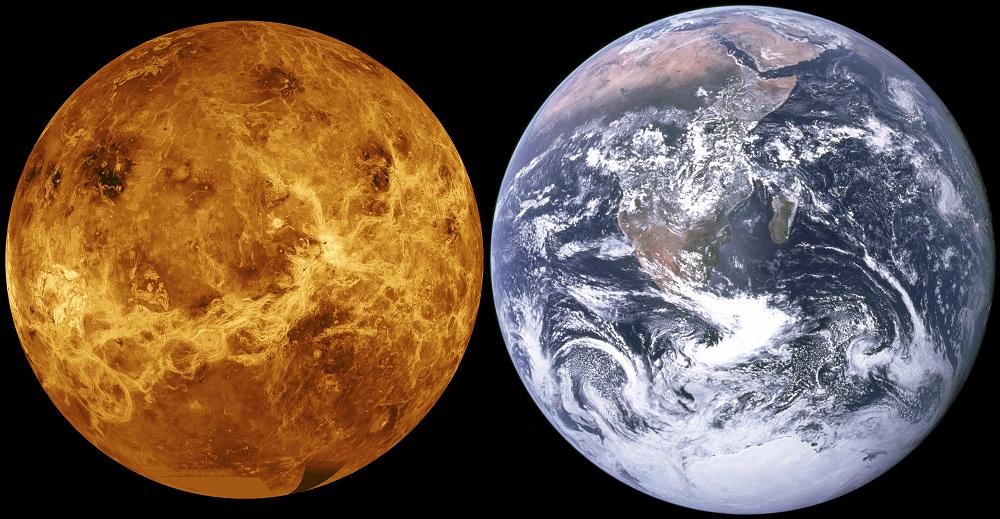
For many reasons, Venus is sometimes referred to as “Earth’s Twin” (or “Sister Planet”, depending on who you ask). Like Earth, it is terrestrial (i.e. rocky) in nature, composed of silicate minerals and metals that are differentiated between an iron-nickel core and silicate mantle and crust. But when it comes to their respective atmospheres and magnetic fields, our two planets could not be more different.
For some time, astronomers have struggled to answer why Earth has a magnetic field (which allows it to retain a thick atmosphere) and Venus do not. According to a new study conducted by an international team of scientists, it may have something to do with a massive impact that occurred in the past. Since Venus appears to have never suffered such an impact, its never developed the dynamo needed to generate a magnetic field.
The study, titled “Formation, stratification, and mixing of the cores of Earth and Venus“, recently appeared in the scientific journal Earth and Science Planetary Letters. The study was led by Seth A. Jacobson of Northwestern University, and included members from the Observatory de la Côte d’Azur, the University of Bayreuth, the Tokyo Institute of Technology, and the Carnegie Institution of Washington.

For the sake of their study, Jacobson and his colleagues began considering how terrestrial planets form in the first place. According to the most widely-accepted models of planet formation, terrestrial planets are not formed in a single stage, but from a series of accretion events characterized by collisions with planetesimals and planetary embryos – most of which have cores of their own.
Recent studies on high-pressure mineral physics and on orbital dynamics have also indicated that planetary cores develop a stratified structure as they accrete. The reason for this has to do with how a higher abundance of light elements are incorporated in with liquid metal during the process, which would then sink to form the core of the planet as temperatures and pressure increased.
Such a stratified core would be incapable of convection, which is believed to be what allows for Earth’s magnetic field. What’s more, such models are incompatible with seismological studies that indicate that Earth’s core consists mostly of iron and nickel, while approximately 10% of its weight is made up of light elements – such as silicon, oxygen, sulfur, and others. It’s outer core is similarly homogeneous, and composed of much the same elements.
As Dr. Jacobson explained to Universe Today via email:
“The terrestrial planets grew from a sequence of accretionary (impact) events, so the core also grew in a multi-stage fashion. Multi-stage core formation creates a layered stably stratified density structure in the core because light elements are increasingly incorporated in later core additions. Light elements like O, Si, and S increasingly partition into core forming liquids during core formation when pressures and temperatures are higher, so later core forming events incorporate more of these elements into the core because the Earth is bigger and pressures and temperatures are therefore higher.
“This establishes a stable stratification which prevents a long-lasting geodynamo and a planetary magnetic field. This is our hypothesis for Venus. In the case of Earth, we think the Moon-forming impact was violent enough to mechanically mix the core of the Earth and allow a long-lasting geodynamo to generate today’s planetary magnetic field.”
To add to this state of confusion, paleomagnetic studies have been conducted that indicate that Earth’s magnetic field has existed for at least 4.2 billion years (roughly 340 million years after it formed). As such, the question naturally arises as to what could account for the current state of convection and how it came about. For the sake of their study, Jacobson and his team considering the possibility that a massive impact could account for this. As Jacobson indicated:
“Energetic impacts mechanically mix the core and so can destroy stable stratification. Stable stratification prevents convection which inhibits a geodynamo. Removing the stratification allows the dynamo to operate.”
Basically, the energy of this impact would have shaken up the core, creating a single homogeneous region within which a long-lasting geodynamo could operate. Given the age of Earth’s magnetic field, this is consistent with the Theia impact theory, where a Mars-sized object is believed to have collided with Earth 4.51 billion years ago and led to the formation of the Earth-Moon system.
This impact could have caused Earth’s core to go from being stratified to homogeneous, and over the course of the next 300 million years, pressure and temperature conditions could have caused it to differentiate between a solid inner core and liquid outer core. Thanks to rotation in the outer core, the result was a dynamo effect that protected our atmosphere as it formed.
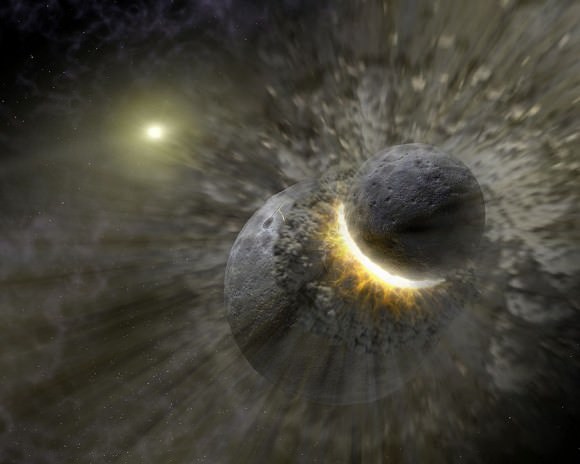
The seeds of this theory were presented last year at the 47th Lunar and Planetary Science Conference in The Woodlands, Texas. During a presentation titled “Dynamical Mixing of Planetary Cores by Giant Impacts“, Dr. Miki Nakajima of Caltech – one of the co-authors on this latest study – and David J. Stevenson of the Carnegie Institution of Washington. At the time, they indicated that the stratification of Earth’s core may have been reset by the same impact that formed the Moon.
It was Nakajima and Stevenson’s study that showed how the most violent impacts could stir the core of planets late in their accretion. Building on this, Jacobson and the other co-authors applied models of how Earth and Venus accreted from a disk of solids and gas about a proto-Sun. They also applied calculations of how Earth and Venus grew, based on the chemistry of the mantle and core of each planet through each accretion event.
The significance of this study, in terms of how it relates to the evolution of Earth and the emergence of life, cannot be understated. If Earth’s magnetosphere is the result of a late energetic impact, then such impacts could very well be the difference between our planet being habitable or being either too cold and arid (like Mars) or too hot and hellish (like Venus). As Jacobson concluded:
“Planetary magnetic fields shield planets and life on the planet from harmful cosmic radiation. If a late, violent and giant impact is necessary for a planetary magnetic field then such an impact may be necessary for life.”
Looking beyond our Solar System, this paper also has implications in the study of extra-solar planets. Here too, the difference between a planet being habitable or not may come down to high-energy impacts being a part of the system’s early history. In the future, when studying extra-solar planets and looking for signs of habitability, scientists may very well be forced to ask one simple question: “Was it hit hard enough?”
Further Reading: Earth Science and Planetary Letters
Beautiful Planetary Rings Are Dead Dwarf Planets! Dead Dwarf Planets!!!
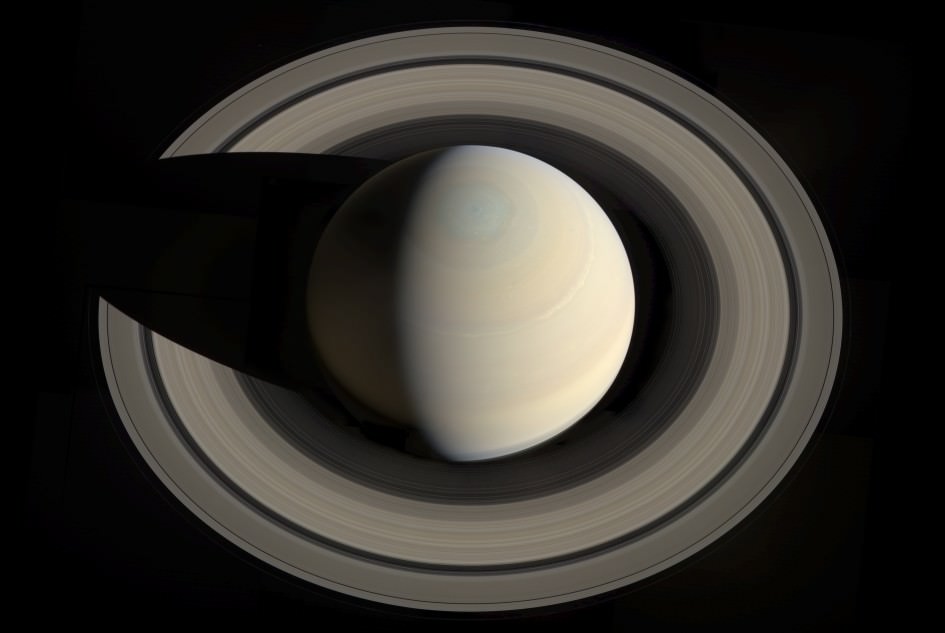
In 1655, astronomer Christiaan Huygens became the first person to observe the beautiful ring system that surrounds Saturn. And while they are certainly the most spectacular, astronomers have since discovered that all the gas and ice giants of the Solar System (i.e. Jupiter, Saturn, Uranus and Neptune) have their own system of rings.
These systems have remained a source of fascination for astronomers, largely because their origins are still something of a mystery. But thanks to a recent study by researchers from the Tokyo Institute of Technology and Kobe University, the origins of these rings may be solved. According to their study, the rings are pieces of Dwarf Planets that got torn off in passing, which were then ripped to pieces!
This research could help to resolve many of the burning questions about the ring systems around our system’s giant planets, as well as details about the Solar Systems past. For the sake of their study – titled “Ring Formation around Giant Planets by Tidal Disruption of a Single Passing Large Kuiper Belt Object” – the Japanese team of researchers considered a number of factors.
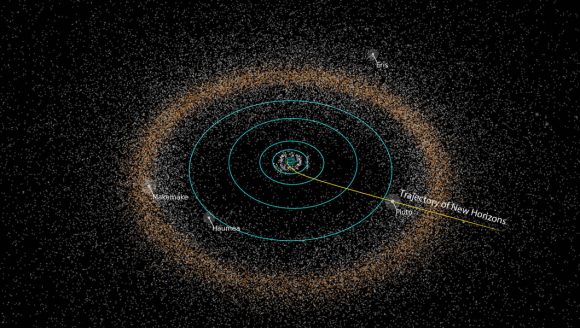
First, they considered the diversity of the various ring systems in our Solar System. For instance, Saturn’s rings are massive (about 100,000 trillion kg!) and composed overwhelmingly (90-95%) of water ice. In contrast, the much less massive rings of Uranus and Neptune are composed of darker material, and are believed to have higher percentages of rocky material in them.
To shed some light on this, the team looked to the Nice Model – a theory of Solar System formation that states that the gas giant migrated to their present location during the Late Heavy Bombardment. This period took place between 4 and 3.8 billion years ago, and was characterized by a disproportionately high number of asteroids from Trans-Neptunian space striking planets in the Inner Solar System.
They then considered other recent models of Solar System formation which postulate that the giant planets experienced close encounters with Pluto-sized objects during this time. From this, they developed the theory that the rings could be the result of some of these objects getting trapped and ripped apart by the gas giants’ gravity. To test this theory, they performed a number of computer simulations to see what would happen in these instances.
As Ryuki Hyodo – a researcher at the Department of Planetology, Kobe University, and the lead author on the paper – told Universe Today via email:
“We performed two simulations. First, using SPH (Smoothed-particle hydrodynamics) simulations, we investigated tidal disruption of Pluto-sized objects during the close encounters with giant planets and calculated the amount of fragments that are captured around giant planets. We found enough mass/fragments to explain current rings is captured. Then, we performed the longer-term evolution of the captured mass/fragments by using N-body simulations. We found that the captured fragments can collide each other with destruction and form thin equatorial circular rings around giant planets.”
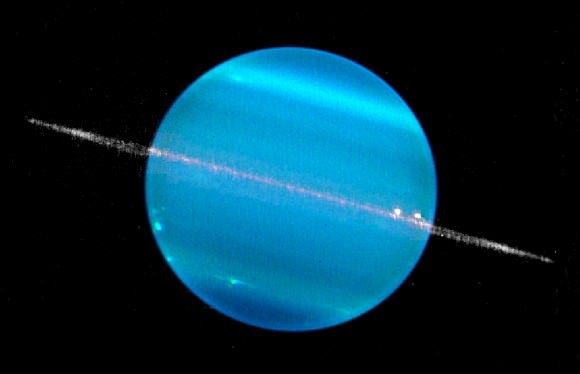
The results of these simulation were consistent with the mass of the ring systems observed around Saturn and Uranus. This included the inner regular satellites of both planets – which would have also been the product of the past encounters with KBOs. It also accounted for the differences in the rings’ composition, showing how the planet’s Roche limits can influence what kind of material can be effectively captured.
This study is especially significant because it offers verifiable evidence for one of the enduring mysteries of our Solar System. And as Hyodo points out, it could come in mighty handy when it comes time to examine extra-solar planetary systems as well.
“Our theory suggested that, in the past, we had two possible epochs to form rings,” he said. “One is during the planet accretion phase and the other is during the Late heavy bombardment. Also, our model is naturally applicable to other planetary systems. So, our theory predicts that exoplanets also have massive rings around them.”
In the meantime, some might find the idea that ring systems are the corpses of Dwarf Planets troublesome. But I think we can all agree, a Soylent Green allusion might be just a bit over the top!
Further Reading: arXiv
The Moon’s Mare Imbrium Was Hit By Protoplanetary Size Impactor

The asteroid that punched an “eye” in the Moon is about 10 times more massive than originally thought. Researchers say a protoplanet-sized body slammed into the Moon about 3.8 billion years ago, creating the area called Imbrium Basin that forms the right eye of the so-called “Man in the Moon.” Additionally, this large body also indicates that protoplanet-sized asteroids may have been common in the early solar system, putting the “heavy” into the Late Heavy Bombardment.
“We show that Imbrium was likely formed by an absolutely enormous object, large enough to be classified as a protoplanet,” said Pete Schultz from Brown University. “This is the first estimate for the Imbrium impactor’s size that is based largely on the geological features we see on the Moon.”
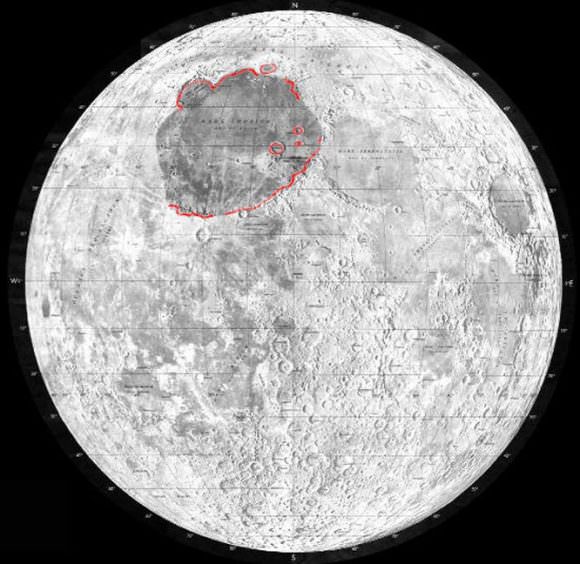
The Imbrium Basin is easily seen when the Moon is full, as a dark patch in the Moon’s northwestern quadrant. It is about 750 miles across, and a closer look shows the basin is surrounded by grooves and gashes that radiate out from the center of the basin, plus a second set of grooves with a different alignment that have puzzled astronomers for decades.
To re-enact the impact, Schultz used the Vertical Gun Range at the NASA Ames Research Center to conduct hypervelocity impact experiments. This facility has a 14-foot cannon that fires small projectiles at up to 25,750 km/hr (16,000 miles per hour), and high-speed cameras record the ballistic dynamics. During his experiments, Schultz noticed that in addition to the usual crater ejecta from the impact, the impactors themselves – if large enough — had a tendency to break apart when they first made contact with the surface. Then these chunks would continue to travel at a high speeds, skimming along and plowing across the surface, creating grooves and gouges.
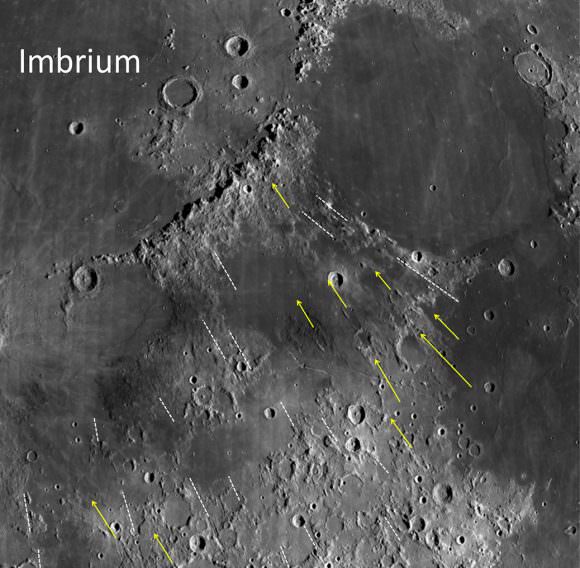
The results showed the second set of grooves were likely formed by these large chunks of the impactor that sheared off on initial contact with the surface.
“The key point is that the grooves made by these chunks aren’t radial to the crater,” Schultz said in a press release. “They come from the region of first contact. We see the same thing in our experiments that we see on the Moon — grooves pointing up-range, rather than the crater.”
The second set of groove trajectories could be used to estimate the impactor’s size. Schultz worked with David Crawford of the Sandia National Laboratories to generate computer models of the physics of various sizes of impactors, and they were able to estimate the impactor that created Imbrium Basin to be more than 250 km (150 miles) across, which is two times larger in diameter and 10 times more massive than previous estimates. This puts the impactor in the range of being the size of a protoplanet.
“That’s actually a low-end estimate,” Schultz said. “It’s possible that it could have been as large as 300 kilometers.”
Previous estimates, Schultz said, were based solely on computer models and yielded a size estimate of only about 50 miles in diameter.
Schultz and his colleagues also used the same methods to estimate the sizes of impactors related to several other basins on the Moon, for example, the Moscoviense and Orientale basins on the Moon’s far side, which yielded impactor sizes of 100 and 110 kilometers across respectively, larger than some previous estimates.
Combining these new estimates with the fact that there are even larger impact basins on the Moon and other planets, Schultz concluded that protoplanet-sized asteroids may have been common in the early solar system, and he called them the “lost giants” of the Late Heavy Bombardment, a period of intense comet and asteroid bombardment thought to have pummeled the Moon and all the planets including the Earth about 4 to 3.8 billion years ago.
“The Moon still holds clues that can affect our interpretation of the entire solar system,” he said. “Its scarred face can tell us quite a lot about what was happening in our neighborhood 3.8 billion years ago.”
Schultz’s study was published in Nature.
Source: Brown University
Uranus’ Moon Umbriel
The 19th century was an auspicious time for astronomers and planet hunters. In addition to the discovery of the Asteroid Belt that rests between Mars and Jupiter – as well as the many minor planets within – the outer solar planet of Uranus and its series of moons were also observed for the very first time.
Of these, Umbriel was certainly one of the most interesting finds. Aside from being Uranus’ third largest moon, it is also its darkest – a trait which contributed greatly to the selection of its name. And to this day, this large satellite of Uranus is shrouded in mystery…
Discovery and Naming:
Umbriel, along with its fellow moon Ariel, was discovered by English astronomer William Lassell on October 24th, 1851. Fellow English astronomer William Herschel, who had discovered Uranus’ moons of Titania and Oberon at the end of the 18th century, also claimed to have observed four additional moons around Uranus. However, his observations were not confirmed, leaving the confirmed discoveries of Ariel and Umbriel to Lassell, roughly half a century later.
Much like all of Uranus’ 27 moons, Umbriel was named after a character from Alexander Pope’s The Rape of the Lock, as well as plays by William Shakespeare. These names were suggested by John Herschel, the son of William Herschel, when he announced the discoveries of Titania and Oberon.
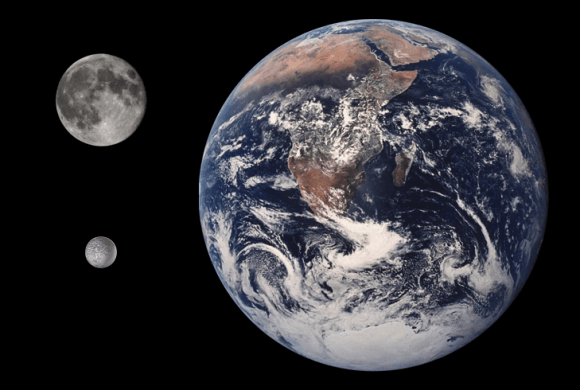
In keeping with the moon’s dark appearance, the name Umbriel – which was the name of the ‘dusky melancholy sprite’ in the The Rape of the Lock and is derived from the Latin Umbra (which means “shadow”) – seemed most appropriate for this satellite.
Size, Mass and Orbit:
Ariel and Umbriel are nearly the same size, with diameters of 1,158 kilometers and 1,170 kilometers respectively. Based on spectrograph analyses and estimates of the moon’s mass and density, astronomers believe that the majority of the planet consists of water ice, with a dense non-ice component constituting around 40% of its mass.
This could mean that Umbriel consists of an icy outer shell that surrounds a rocky core, or one made out of carbonaceous materials. It also means that though Umbriel is the third largest moon of Uranus, it is only the fourth largest in terms of mass. Furthermore, its dark appearance is believed to be the result of the interactions of surface water ice with energetic particles from Uranus’ magnetosphere.
These energetic particles would cause methane deposits (trapped in the ice as clathrate hydrate) to decompose and other organic molecules to darken, leaving behind a dark, carbon-rich residue. The satellite’s dark color is also due to its very low bond albedo – which is basically the amount of electromagnetic radiation (i.e. light) that gets reflected back from the surface.
So far, spectrographic analyses have only confirmed the existence of water and carbon dioxide. So the existence of organic particles or methane deposits in the ice remains theoretical. However, their presence would explain the prevalence of CO² and why it is concentrated mainly on the trailing hemisphere.
Umbriel’s orbital period – i.e. the time it takes the moon to orbit Uranus – is approximately 4.1 days, which is coincident with its rotational period. This means that the moon is a synchronous and tidally-locked satellite, with one face always pointing towards Uranus. The satellite is at an average distance of 266,000 kilometers from its planet, which makes it the third farthest from Uranus, behind Miranda and Ariel.
Voyager 2:
So far, the only close-up images of Umbriel have been provided by the Voyager 2 probe, which photographed the moon during its flyby of Uranus in January of 1986. During this flyby, the closest distance between Voyager 2 and Umbriel was 325,000 km (202,000 mi).
The images cover about 40% of the surface, but only 20% was photographed with the quality required for geological mapping. At the time of the flyby, the southern hemisphere of Umbriel was pointed towards the Sun – so the northern, darkened hemisphere could not be studied. At present, no future missions are planned to study the moon in greater detail.
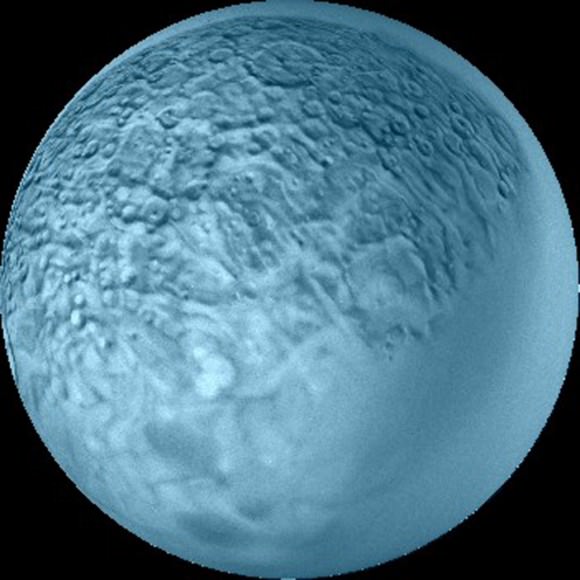
Interesting Facts:
The surface of Umbriel has far more and larger craters than do Ariel and Titania, ranging in diameter from a few kilometers to several hundred. The largest known crater on the surface is Wokolo, which is 210 km in diameter. Wunda, a crater with a diameter of about 131 kilometers, is the most noticeable surface feature, due to the ring of bright material on its floor (which scientists think are from the impact).
Other craters include Fin, Peri, and Zlyden which, like all of Umbriel’s surface features, are named after dark sprites from different cultures’ mythology. The only satellite of Uranus to have more craters is Oberon, and the planet is believed to be geologically stable.
It is further believes that surface has probably been stable since the Late Heavy Bombardment. The only signs of ancient internal activity are canyons and dark polygons – dark patches with complex shapes measuring from tens to hundreds of kilometers across. The polygons were identified from precise photometry of Voyager 2′s images and are distributed more or less uniformly on the surface of Umbriel, trending northeast – southwest.
Because Uranus orbits the Sun almost on its side, it is subject to an extreme seasonal cycle. Both northern and southern poles spend 42 years in complete darkness, and another 42 years in continuous sunlight, with the Sun rising close to the zenith over one of the poles at each solstice.
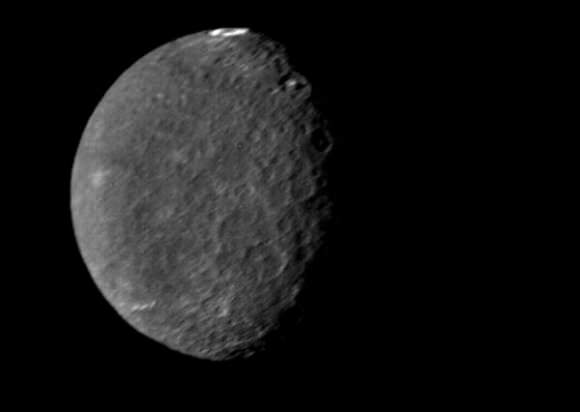
Because they are in the planet’s equatorial plane, Uranus’ satellites also experience these changes. This means that Umbriel’s north and south poles spend 42 years in light and then 42 years in darkness before repeating the cycle. In fact, the Voyager 2 flyby coincided with the southern hemisphere’s 1986 summer solstice, when nearly the entire northern hemisphere was in darkness.
Interesting little moon isn’t it? Even though no missions are currently planned to observe it in the coming years, one can only hope that future satellites happen to sneak a peek at it on their way to some other destination in the outer Solar System.
Universe Today has many interesting articles on the moons of Uranus, like how many moons does Uranus have?
You should also check out NASA’s page on Umbriel and Uranus’ moon Umbriel at Nine Planets.
Astronomy Cast has an episode on Uranus that you should check out.
Sources:
Asteroid That Dwarfed Dinosaur-Killer Punched Earth 3 Billion Years Ago, Study Says
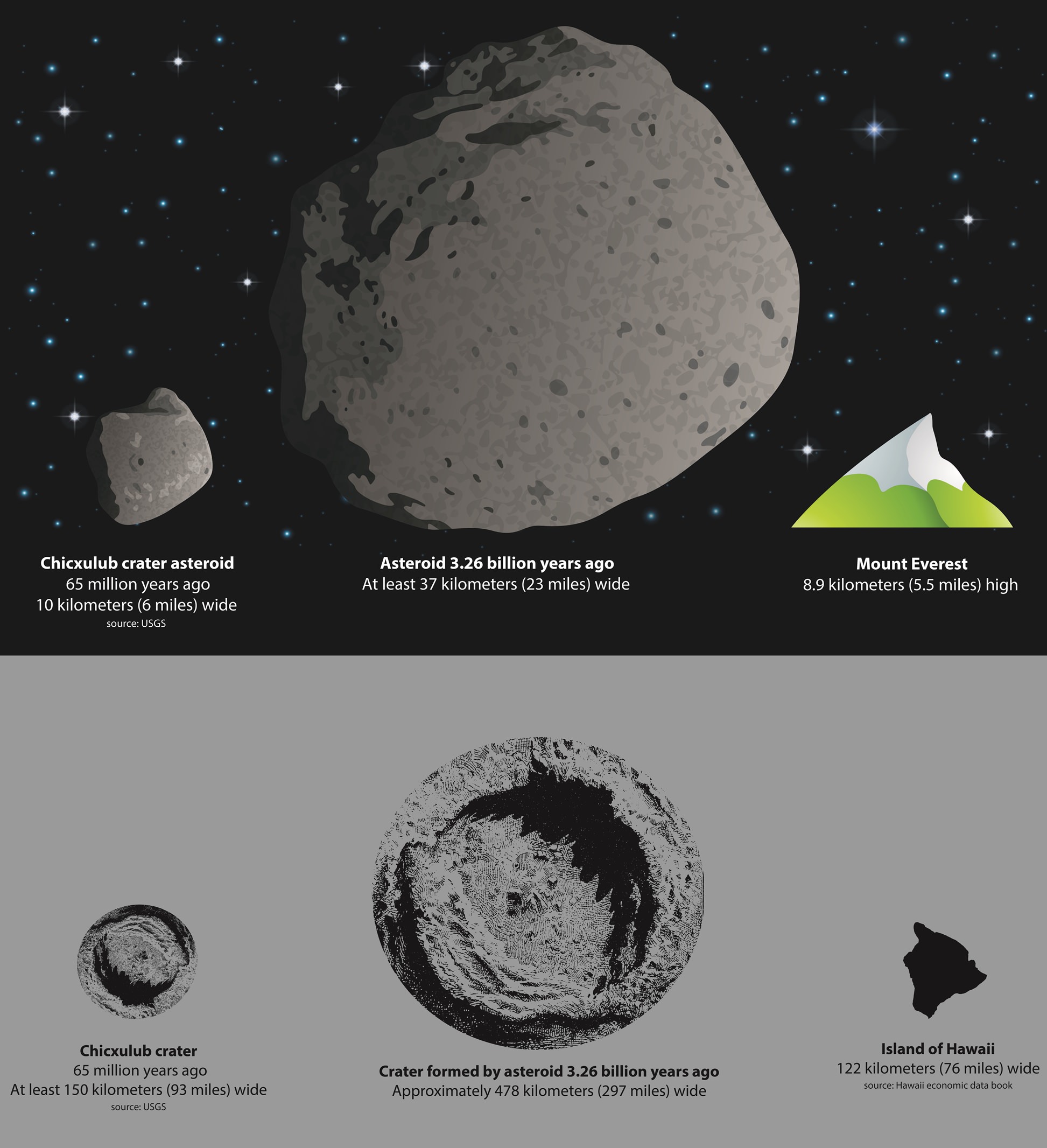
Early in Earth’s history, a killer asteroid smashed a hole in our planet about 300 miles (500 kilometers) wide, which is greater than the driving distance between Washington and New York City, a new study says. The space rock set off a cycle of destruction that sounds like your worst nightmares.
That one reported collision 3.26 billion years ago made the Earth tremble, created earthquakes and set off tsunamis that were thousands of meters deep, according to a new research team. The size of this estimated destructor? About 37 kilometers (23 miles) wide, or about three times as wide as the asteroid that killed the dinosaurs 65 million years ago.
“We knew it was big, but we didn’t know how big,” stated co-author Donald Lowe, a geologist at Stanford University and a co-author of the study, of the asteroid.
Evidence of the huge impact — the first one mapped from so long ago — comes from an examination of the Barberton Greenstone Belt in South Africa, which shows rocks and “crustal fractures” that are consistent with the idea of a giant impact, the scientists said. (The asteroid struck the Earth thousands of miles away, but where isn’t known.)
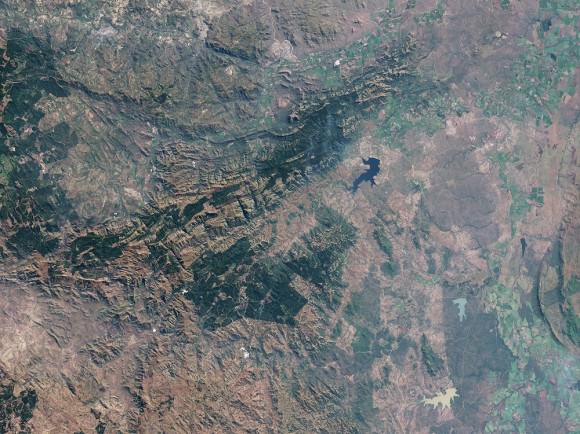
If confirmed, the asteroid could have been one of many that smacked Earth during what is known as the Late Heavy Bombardment period, which pummeled the solar system with debris between 3 billion and 4 billion years ago.
This one event could even have changed the way the Earth formed, the scientists added. For example, it could have been broken up our planet’s crust and tectonics, creating the plate tectonics we are familiar with today.
You can read more about the research in the journal Geochemistry, Geophysics, Geosystems. It was led by Norman Sleep, a geophysicist at Stanford University.
Source: American Geophysical Union
What Craters on the Moon Teach Us About Earth
When the Moon was receiving its highest number of impacts, so was Earth. Credit: Dan Durda
Some questions about our own planet are best answered by looking someplace else entirely… in the case of impact craters and when, how and how often they were formed, that someplace can be found shining down on us nearly every night: our own companion in space, the Moon.
By studying lunar impact craters both young and old scientists can piece together the physical processes that took place during the violent moments of their creation, as well as determine how often Earth — a considerably bigger target — was experiencing similar events (and likely in much larger numbers as well.)
With no substantial atmosphere, no weather and no tectonic activity, the surface of the Moon is a veritable time capsule for events taking place in our region of the Solar System. While our constantly-evolving Earth tends to hide its past, the Moon gives up its secrets much more readily… which is why present and future lunar missions are so important to science.
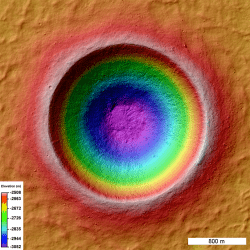 Take the crater Linné, for example. A young, pristine lunar crater, the 2.2-km-wide Linné was formed less than 10 million years ago… much longer than humans have walked the Earth, yes, but very recently on lunar geologic terms.
Take the crater Linné, for example. A young, pristine lunar crater, the 2.2-km-wide Linné was formed less than 10 million years ago… much longer than humans have walked the Earth, yes, but very recently on lunar geologic terms.
It was once thought that the circular Linné (as well as other craters) is bowl-shaped, thus setting a precedent for the morphology of craters on the Moon and on Earth. But laser-mapping observations by NASA’s Lunar Reconnaissance Orbiter (at right) determined in early 2012 that that’s not the case; Linné is actually more of a truncated inverted cone, with a flattened interior floor surrounded by sloping walls that rise up over half a kilometer to its rim.
On our planet the erosive processes of wind, water, and earth soon distort the shapes of craters like Linné, wearing them down, filling them in and eventually hiding them from plain sight completely. But in the Moon’s airless environment where the only weathering comes from more impacts they retain their shape for much longer lengths of time, looking brand-new for many millions of years. By studying young craters in greater detail scientists are now able to better figure out just what happens when large objects strike the surface of worlds — events that can and do occur quite regularly in the Solar System, and which may have even allowed life to gain a foothold on Earth.
Most of the craters visible on the Moon today — Linné excluded, of course — are thought to have formed within a narrow period of time between 3.8 and 3.9 billion years ago. This period, called the Late Heavy Bombardment, saw a high rate of impact events throughout the inner Solar System, not only on the Moon but also on Mars, Mercury, presumably Venus and Earth as well. In fact, since at 4 times its diameter the Earth is a much larger target than the Moon, it stands to reason that Earth was impacted many more times than the Moon as well. Such large amounts of impacts introduced material from the outer Solar System to the early Earth as well as melted areas of the surface, releasing compounds like water that had been locked up in the crust… and even creating the sorts of environments where life could have begun to develop and thrive.
(It’s been suggested that there was even a longer period of heavy impact rates nicknamed the “late late heavy bombardment” that lingered up until about 2.5 billion years ago. Read more here.)
In the video below lunar geologist David Kring discusses the importance of impacts on the evolution of the Moon, Earth and eventually life as we know it today:
“Impact cratering in Earth’s past has affected not only the geologic but the biologic evolution of our planet, and we were able to deduce that in part by the lessons we learned by studying the Moon… and you just have to wonder what other things we can learn by going back to the Moon and studying that planetary body further.”
– David Kring
David is a senior staff scientist at the Lunar and Planetary Institute in Houston, TX.
It’s these sorts of connections that make lunar exploration so valuable. Keys to our planet’s past are literally sitting on the surface of the Moon, a mere 385,000 km away, waiting for us to just scoop them up and bring them back. While the hunt for a biological history on Mars or resource-mining an asteroid are definitely important goals in their own right, only the Moon holds such direct references to Earth. It’s like an orbiting index to the ongoing story of our planet — all we have to do is make the connections.
Learn more about lunar research at the LPI site here, and see the latest news and images from LRO here.
Ancient Asteroids Kept Pelting Earth in a ‘Late-Late’ Heavy Bombardment

[/caption]
Even though the Late Heavy Bombardment is somewhat of a controversial idea, new research has revealed this period of impacts to the Earth-Moon system may have lasted much longer than originally estimated and well into the time when early life was forming on Earth. Additionally, this “late-late” period of impacts — 3.8 billion to 2.5 billion years ago — was not for the faint of heart. Various blasts may have rivaled those that produced some of the largest craters on the Moon, and could have been larger than the dinosaur-killing impact that created the Chicxulub crater 65 million years ago.
“Our work provides a rationale that the last big impacts hit over an extended time,” said William Bottke principal investigator of the impact study team at the NASA Lunar Science Institute’s Center of Lunar Origin and Evolution (CLOE), based at the Southwest Research Institute (SwRI) in Boulder, Colorado.
The evidence for these prodigious impacts comes from bead-like impact ‘spherules’ found in millimeter- to centimeter-thick rock layers on Earth and date from the Archean period of Earth’s history, more recent than the estimated LHB period of 4.1 to 3.8 billion years ago.
“The beds speak to an intense period of bombardment of Earth,” Bottke said. “Their source long has been a mystery.”
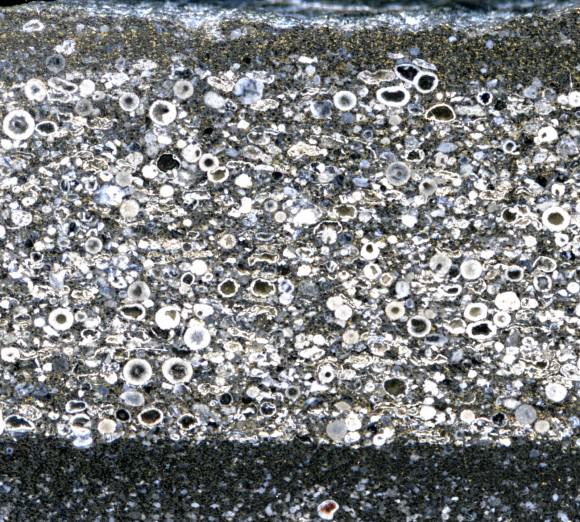
The circles seen in the image above are all formerly molten droplets ejected into space when an asteroid struck the Earth about 2.56 billion years ago. The droplets returned to Earth and were concentrated at the base of the Reivilo layer in South Africa.
The spherules still contain substantial extraterrestrial material, such as iridium (176 parts per million), which rules out alternative sources for the spherules, such as volcanoes, according to Bruce Simonson, a geologist from the Oberlin College and Conservatory who has studied these ancient layers for decades.
The timing of these impacts also coincides with a record of large lunar craters being created more recently than 3.8-billion years ago.
At least 12 spherule beds deposited between 3.47 and 1.7 billion years ago have been found in protected areas on Earth, such as in shales deposited on the seafloor below the reach of waves.
From these beds, the team found evidence of approximately 70 impacts on Earth during this time period that were likely larger than the Chicxulub impact.
In their paper, which was published in Nature, the team created a computer model of the ancient main asteroid belt and tracked what would have happened when the orbits of the giant planets changed. They extended the work of the Nice Model, which supports the theory that Jupiter, Saturn, Uranus and Neptune formed in different orbits nearly 4.5 billion years ago and migrated to their current orbits about 4 billion years ago, triggering a solar system-wide bombardment of comets and asteroids called known as the LHB.
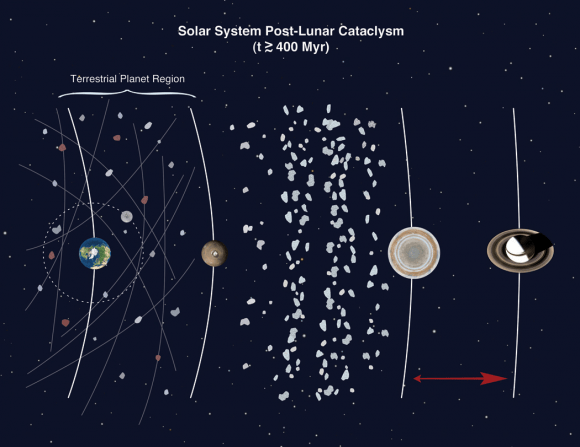
The new computer model shows that the innermost portion of the asteroid belt could have become destabilized, delivering numerous big impacts to Earth and Moon over longer time periods.
Have there been any previous indications about this period of impacts?
“The problem is that we have almost no Archean rocks,” Bottke told Universe Today. “The oldest terrestrial craters, Sudbury and Vredefort, are 1.85 and 2.02 billion years old. The spherule beds are our only window into impacts prior to this time.”
Also, Bottke said, the number of people who look for impact spherules is almost equally scarce. “People such as Bruce Simonson, Don Lowe, Gary Byerly, and Frank Kyte, have been carrying on a long, lonely quest to try to get people to consider the implications of their work, which are deeply profound, in my opinion,” Bottke said.
As for finding evidence of this later period of impacts on the Moon, Bottke said the problem there is the lack of solid ages for most impact events.
“This means it is difficult say anything definitive about the timing of major impacts,” Bottke said. “We are working this problem now with Michelle Kirchoff, who is counting craters on top of large lunar craters. This can be done now that we have LRO data.” (Listen to a podcast interview of Kirchoff on the 365 Days of Astronomy.)
Still, Bottke said, without using “fancy dynamics,” they can address some issues.
“Studies in the post-Apollo era suggested that the Moon has four 160-300 km craters that formed after Orientale, whose age is 3.7-3.8 billion years ago and (i.e., K/T-sized events or larger),” he said. “Crater counts from the Galileo mission and Apollo-era geologic analyses suggest at least one of these events took place near 3.2-3.5 billion years ago. If we account for the gravitational cross section of the planets, we know that for every lunar event, we should get about 20 on the Earth. So, from this argument alone, one should get a lot of big impacts on the Earth after the formation of Orientale.”
The new study fits with the available constraints about impacts on the Moon as well as finding the right distribution of spherule beds on Earth.
The best way to confirm everything, however, Bottke said, would be if more lunar rocks from various locations were available for study.
Read the team’s paper in Nature.
Further reading:
Press release from SwRI.
NLSI press release
New Research Casts Doubt on the Late Heavy Bombardment
[/caption]
Was the early solar system bombarded with lots of big impacts? This is a question that has puzzled scientists for over 35 years. And it’s not just an academic one. We know from rocks on Earth that life began to evolve very early on, at least 3.8 billion years ago. If the Earth was being pummeled by large impacts at this time, this would certainly have affected the evolution of life. So, did the solar system go through what is known as the Late Heavy Bombardment (LHB)? Exciting new research, using data from the Lunar Reconnaissance Orbiter Camera (LROC) may cast some doubt on the popular LHB theory.
It’s actually quite a heated debate, one that has polarized the science community for quite some time. In one camp are those that believe the solar system experienced a cataclysm of large impacts about 3.8 billion years ago. In the other camp are those that think such impacts were spread more evenly over the time of the early solar system from approximately 4.3 to 3.8 billion years ago.
The controversy revolves around two large impact basins, which are found fairly close to each other on the Moon. The Imbrium basin is one of the youngest basins on the near side of the Moon, while the Serenetatis basin is thought to be one of the oldest. Both are flooded with volcanic basalts and are big enough to be seen from Earth with the naked eye.
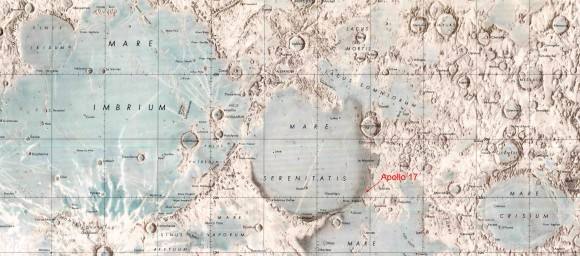
What if the Apollo 17 samples didn't come from the Serenitatis basin, where the astronauts collected them, but rather from the Imbrium basin, located some 600 km away? Studies from the new Lunar Reconnaissance Orbiter Camera suggest this may be the case. If true, this means Serenitatis is much older than the Imbrium basin and a solar system-wide impact catastrophe is not needed to explain the uncannily close ages of the Imbrium and Serenitatis basins.
Image credit: NASA
Click on the image to download the full map and explore it in more detail.
Scientists know the relative ages of such lunar basins because of a concept called superposition. Basically, superposition states that what is on top must be younger than what is beneath. Using such relationships, scientists can determine which basins are older and which are younger.
To get an absolute age, though, scientists need actual bits of rock, so they can use radiometric dating techniques. The lunar samples returned by the Apollo program provided exactly that. But, the Apollo samples suggest that the Imbrium and Serenitatis basins are barely 50 million years apart.
Relative age dating tells us there are over 30 other basins that formed within that time frame. This means that roughly one major impact occurred every 1.5 million years! Now, 1.5 million years may sound like a long time. But consider the last large impact that happened on Earth, the Chicxulub event 65 million years ago, which is thought to have exterminated the dinosaurs. Imagine another 40 dinosaur-killing impacts occurring since then. It would be surprising if any life survived such a barrage!
This is why a team of researchers, led by Dr. Paul Spudis of the Lunar and Planetary Institute, is looking very carefully at this question. Their research is using the principle of superposition to show that several of the areas visited by the Apollo program were blanketed by material from the Imbrium impact. This could mean that many of the collected Apollo materials may be sampling the same event.
Dr. Spudis’s research focuses on the Montes Taurus area, between the Serenitatis and Crisium basins, not far from the Apollo 17 landing site. This is a region dominated by sculpted hills that have been interpreted to be ejected material from the adjacent Serenitatis basin impact. But, Dr. Spudis and his team have found that, instead, this sculpted material comes from the Imbrium basin some 600 kilometers away.
Previous data of this area, from the Lunar Orbiter IV camera, hadn’t shown this because a fog on the camera lens made the details difficult to see (this fog problem was eventually resolved, and Lunar Orbiter IV provided a lot of useful data on other parts of the Moon).The new LROC data, however, shows that the sculpted terrain seen at Apollo 17 is very widespread, extending far beyond the Montes Taurus region. Furthermore, the grooves and lineated features of this terrain point to the Imbrium basin, not the Serenitatis basin, and line up with similar features in the Alpes and Fra Mauro Formations, which are known to be ejecta from the Imbrium impact. In the north of Serenitatis, these Imbrium formations even seem to transform into the Montes Taurus, confirming that the sculpted hills do, in fact, originate from the Imbrium impact.
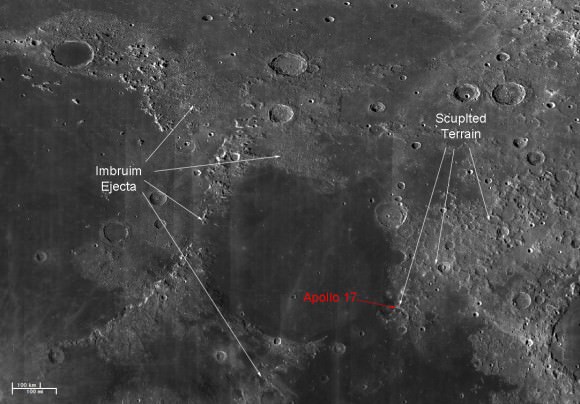
Image credit: NASA/GSFC/Arizona State University
Click on the image to explore the LROC data in greater detail.
If the sculpted hills are Imbruim ejecta, then it is possible that Apollo 17 sampled Imbrium and not Serenitatis materials. That casts suspicion on the very close radiometric ages of these two basins. Perhaps these ages are so close because we effectively measured the same material. In that case, the age of Serenitatis could be much older than the 3.87 billion years the Apollo 17 samples suggest. If true, this would mean that there was no Late Heavy Bombardment at the time life was forming on the early Earth, leaving life to evolve with relatively few impact-related interruptions.
Source:
Spudis et al., 2011, Journal of Geophysical Research, V116, E00H03
A Cometary Case for Titan’s Atmosphere
[/caption]
Titan is a fascinating world to planetary scientists. Although it’s a moon of Saturn it boasts an opaque atmosphere ten times thicker than Earth’s and a hydrologic cycle similar to our own – except with frigid liquid methane as the key component instead of water. Titan has even been called a living model of early Earth, even insofar as containing large amounts of nitrogen in its atmosphere much like our own. Scientists have wondered at the source of Titan’s nitrogen-rich atmosphere, and now a team at the University of Tokyo has offered up an intriguing answer: it may have come from comets.
Traditional models have assumed that Titan’s atmosphere was created by volcanic activity or the effect of solar UV radiation. But these rely on Titan having been much warmer in the past than it is now…a scenario that Cassini mission scientists don’t think is the case.
New research suggests that comet impacts during a period called the Late Heavy Bombardment – a time nearly 4 billion years ago when collisions by large bodies such as comets and asteroids were occurring regularly among worlds in our solar system – may have generated Titan’s nitrogen atmosphere. By firing lasers into ammonia-and-water-ice material similar to what would have been found on primordial Titan, researchers saw that nitrogen was a typical result. Over the millennia these impacts could have created enough nitrogen to cover the moon in a dense haze, forming the thick atmosphere we see today.
“We propose that Titan’s nitrogen atmosphere formed after accretion, by the conversion from ammonia that was already present on Titan during the period of late heavy bombardment about four billion years ago.”
– Yasuhito Sekine et al., University of Tokyo, Japan
This model, if true, would also mean that the source of Titan’s nitrogen would be different than that of other outer worlds, like Pluto, and even inner planets like our own.
See the published results in the journal Nature, or read more on NewScientist.com.
Top image is a combination of a color-composite of Titan made from raw Cassini data taken on October 12, 2010 and a recolored infrared image of the comet Siding Spring, taken by NASA’s WISE observatory on January 10, 2010. The background stars were also taken by the Cassini orbiter. NASA / JPL / SSI and Caltech/UCLA. Edited by J. Major.
Note: the image at top is not scientifically accurate…the comet’s tail would be, based on the lighting of Titan, pointing more to the ten o’clock position as well as forward toward the viewer’s left shoulder. This would make it ‘look’ as if it were going the opposite direction though, away from Titan, and so I went with the more immediately decipherable version seen here. To see a more “realistic” version, click here.

